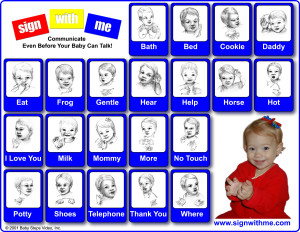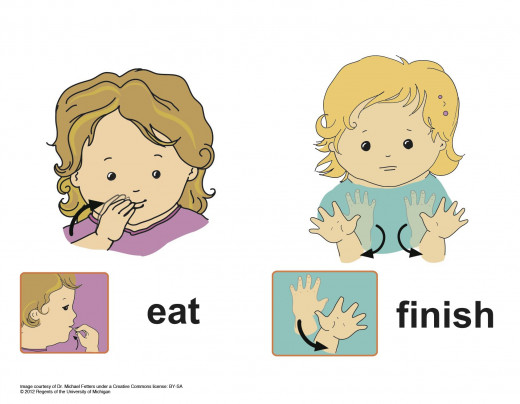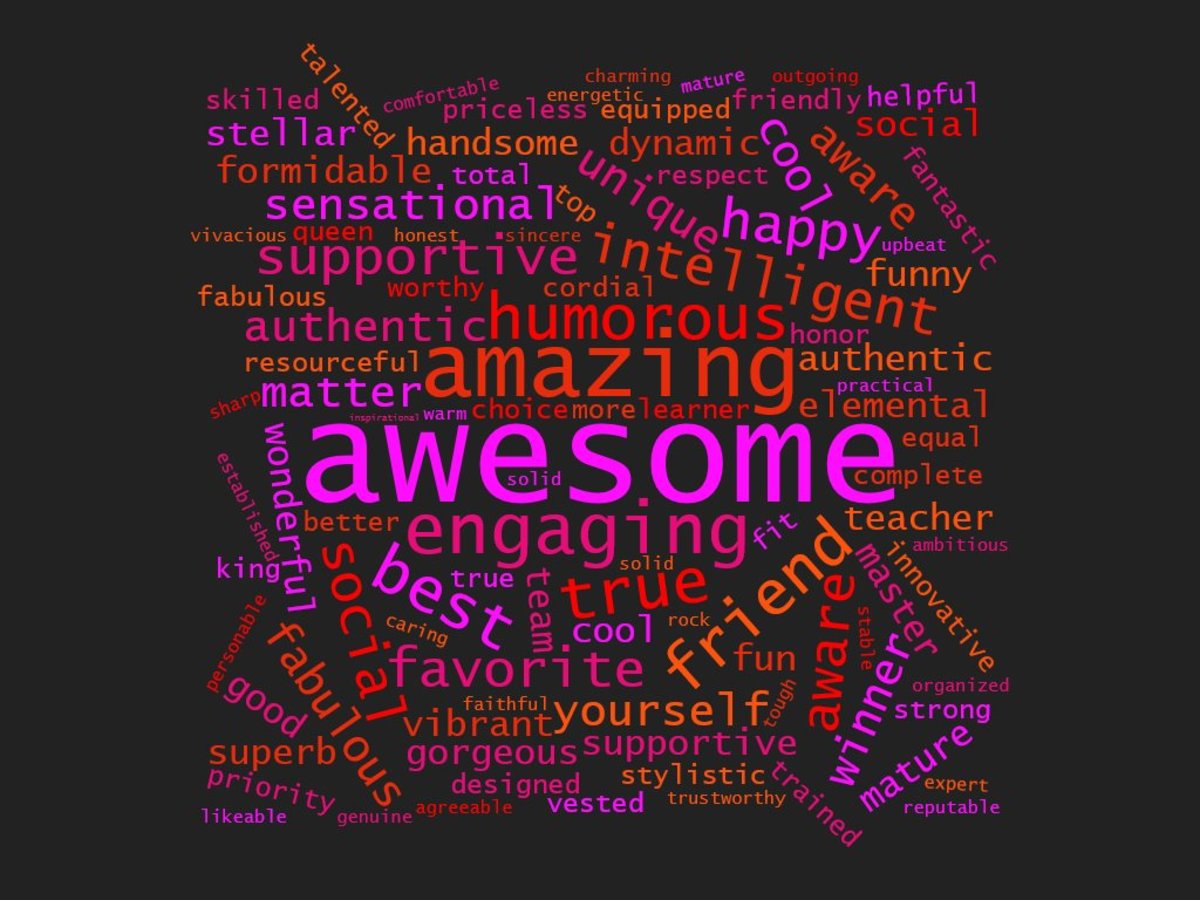- HubPages»
- Family and Parenting»
- Parenting Skills, Styles & Advice»
- Parenting Advice & Tips
Baby Signs - Understand Your Child Before They Can Speak
Communicate Easily with Your Child
Baby sign language makes understanding your currently non-verbal child's needs, wants. questions and worldly observations easy! Using signs, gestures and body movement, baby sign is usually designed for those children who are hearing - if your child has hearing impairment, it would be best to teach/learn your nation's sign language:
- British Sign Language (BSL),
- American Sign Language (ASL),
- New Zealand Sign Language (NZSL)
- Australian Sign Language (Auslan)
However, if you have a hearing baby, and wish you could completely understand their needs and wants - Baby Sign could be the solution for you. It can be started at any time, however those under 6mths may not start signing back until 6-10mths of age - but that does not mean they aren't taking in the information!
This particular hub is based largely on the book Baby Sign Language for Hearing Babies by Karyn Warburton, pictured to the right (Green in 2004 edition, White is 2006 edition). Baby sign is also based on signs used by the Deaf community, but is not a substitution for adult sign language.

Benefits of Baby Sign: For You and Your Child
In 1989, two women, Linda Acredolo (PhD) and Susan Goodwyn (PhD) were granted government money to study 100 families with children aged 11months - with many factors taken into account to make sure that the children were on equal footing prior to beginning the study.
One third of the families were shown 'baby sign', another third asked to use "language intervention" - modelling spoken words more than they would normally, and the final third were advised to continue interacting with their children as normal.
All the families were followed for two years and the results compared children using the baby signs to the other two groups.
Those using Baby Sign performed better in all comparisons including:
- Understanding more words, larger vocabularies.
- Engaging in more sophisticated play
- Scoring higher in intelligence tests
Advantages in other areas were noted by both the researchers and the parents of the signing children including:
- Greater interest in books and reading
- Better self-confidence
- Parent-child bond strengthened
- Less frustration and less tantrums
- Communication increase
At the age of 8 - the children were followed up again - those who signed as babies scored higher in IQ tests with an average of 114, than those who did not - who averaged 102.
Why Use Baby Sign?
There are many reasons why you should use Baby Sign with your child, as well as huge benefits for you and your child.
Signing is fun - for both of you. Baby will enjoy being able to connect with you in a different way, and about all the things that interest them. You will gain knowledge of the level of understanding your child has of the world around him, and be able to work with your child on things that interest them - all with simple gestures.
Signing also makes word visual - this assists with explaining abstract concepts such as "wind" - something they cannot see, but can definitely feel on their skin. An iconic gesture makes this easily and quickly understood.
Immersing a child in language, both sign and spoken, will give the child a higher understanding of words and concepts - much of this is due to the fact that when a child displays an interest in a concept or thing, we tend to give them more information automatically.
Being able to express their wants, needs and interests before they are able to verbally express them lessens the frustration experienced by a toddler, and in turn the "hair-pulling" of the parents trying to figure out exactly what is making their child frustrated.
Some Basic Signs

Baby Sign
Teaching your baby to sign?
Development of Language and Sign Language
Babies actually comprehend more about the world around them than they are able to convey, particularly about language. From observing your body language and facial expressions, coupled with the sounds you are making, babies rely heavily on visual cues when learning about speech.
Due to the complex nature of actually producing spoken language, speech comes later than the child's ability to understand the spoken word. They need to perfect many fine motor skills in the mouth and throat before being able to produce exact sounds - however they do practice this endlessly by making all sorts of coos and noises, usually when you want them to sleep! The development of language is highly individual to each child - however, those who sign seem to talk earlier than those who do not.
This is often put down to the fact that signing children have a "multi-sensory experience" of language by utilising three modes of input, and stimulating brain development. These three modes are:
- Auditory - The child can hear the words spoken aloud
- Visual - By watching your facial expressions, body language, mouth shape, and the physical sign for the word, the child can "see" the word you are showing him
- Kinetic - Repetitive physical movement involved in making a sign creates a lasting impression in the memory of the child - learning best by doing.
Simple Signs

Can I Prepare My Child to Learn Sign?
It is recommended that you start teaching your child signs from approximately six months - prior to this their muscle control and other necessary abilities are not quite fully developed enough to be able to get the most out of this.
However, there are many things you can do to prepare your child for learning sign. One of these is providing as many opportunities for your child to explore their world, manipulate objects and discover things. This helps them to learn and improve dexterity, learn about action-reaction/cause and effect, making choices, solve simple problems on their own, anticipate an outcome and understand more about their environment. It causes them to become more observant, and teaches the importance of maintaining eye contact.
Ways to do this:
- Copy cat games such as "everybody wave", "everybody clap" - waving or clapping and encouraging the child to copy. Another is "Touchy-feely" - touch your head and say 'Mummy's head" then touch the child's head and say "Josh's head" etc. Or copying baby's babbles to encourage conversation skills
- Manipulation games - which help with fine and gross motor skills, hand-eye coordination, memory, turn taking, and concentration skills - games such as "Basket of Discovery" - baby friendly items in a basket for your baby to discover and play with, or Sorting - placing objects into containers for fun
- Bonding games - babies love squeezing games - hug them a little tighter and say "squeeze" then release. This stimulates the brain and is crucial to a strong bond with your baby. Dancing, singing, reading stories - these are wonderful ways to bond with your baby.
- Peekaboo games
How Can I Tell My Child is Ready?
Babies are highly individual, and don't always go to a 'script' of when and where they will learn and use new skills, so you have to be observant. Some babies are very alert and interested in what you are doing around 6 months, others aren't terribly interested until later around 10mths. Being observant is key!
Things you should watch out for as signs your baby is ready to begin to learn sign language:
- Your baby is very intently watching your face as you talk, and even trying to make similar movements with their own mouth. You may even have a baby who likes to tell long stories in their own voice.
- Looking around at everything when out. Infants are very good at getting attention by smiling at others when you are out, even squealing, or grabbing at people to get their attention
- Your baby may be subtly asking you names for objects - by looking at the object, at you then back at the object. Pointing is very useful for them also!
- They may take more interest in your story times, and like to point at pictures and be told what they are.
- Is your child already waving or clapping? Then they are definitely ready!
Traditional Signs? Or Your Own?
Whilst Baby Sign is based on basic sign language, it isn't all formal sign language. Nor do you and your child have to follow the signs to the letter - your child only needs to be understood by those who have a lot to do with them such as yourself, their carers or other family members.
Children will also make their own signs - the most common is "Up" - raising their arms above their head to be picked up - universally understood, and wonderfully simple.
My daughter uses a pointing finger, and a opening-close motion with the rest of the fingers on the same hand to tell us she wants something - either to eat, to look at or to know what it is. It is almost like her "Please", or "What's that?". When we realised what she was asking, it made for a MUCH less frustrated baby!
Keen to give it a go? It's never too late to start! Enjoy yourself, relax, and find out what your children are thinking!




